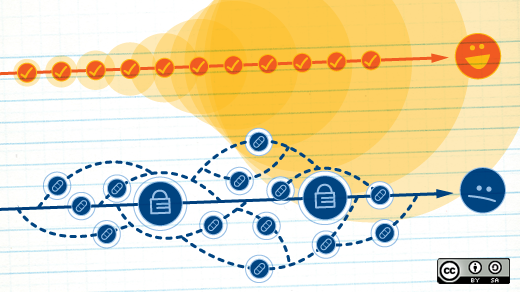Perhaps you’ve considered migrating your company to an open source desktop productivity suite? There are a host of good reasons for such a move. The most obvious one that comes to mind is to save on license fees, but don’t be fooled. For the migration process to be a success and the full benefits to be reaped, you must invest in the changeover itself. Don’t believe that because you want to save money long term you should skimp short-term. A look at the City of Freiburg’s attempted migration reveals the dangers of treating the new software as a drop-in replacement.
The true benefits of the change arise not from avoiding license fees but from the flexibility your company gains. That flexibility comes from cross platform interoperability and the longevity given to the tools and file formats you are free to use. Even simple changes can make a big difference. For example, a company-wide policy of using hybrid PDF format for all documents distributed internally is a significant first step into freedom. Distributing editable document versions of any format, open or not, encourages unnecessary complexity at the desktop as well as potentially limiting the life of your corporate memory.
Together these benefits give a significant level of control over your IT environment and the far lower rate of change makes documents accessible for the longest possible time. That stability alone ensures that the features in use across your company’s ecosystem are as interoperable as possible. Thus the savings come a little further down the line, once the new system is up and running, and not just as a result of the changeover.
To make sure that the changeover to open document formats and open source tools is a successful one (bringing all the desired benefits and being adopted quickly by staff), requires planning, foresight, and intentionality with regard to the migration process itself. Continuing their practice of creating resources and "letting the work do the talking," The Document Foundation has recently issued a white paper explaining how to conduct a successful migration. Naturally TDF use LibreOffice as the open source suite to install, but other open source alternatives work just as well with the same ideas.
The migration guide condenses the hard-won experiences of a number of community contributors who make their living consulting on office productivity migrations. It walks through a 10-step plan, involving everything from analysis of your existing practices through training strategies and implementation of the new software and beyond into recording and learning from the process itself. Hopefully the paper will evolve as the community adds its experience—it’s a hybrid PDF after all, anyone can edit it and this would make a great focus for the cross-community collaboration some folk are calling for.
Already, The Document Foundation's migration guide has a wealth of good advice, highlighting the need for planning, preparation and ongoing funding for making a change of this nature to your companies working habits. The obvious subtext to the document’s creation is that with the growing importance of the open Web and interoperability, making the migration to open source tools and formats is a consideration worth serious thought. It’s a change which may just make the difference for your company.





2 Comments